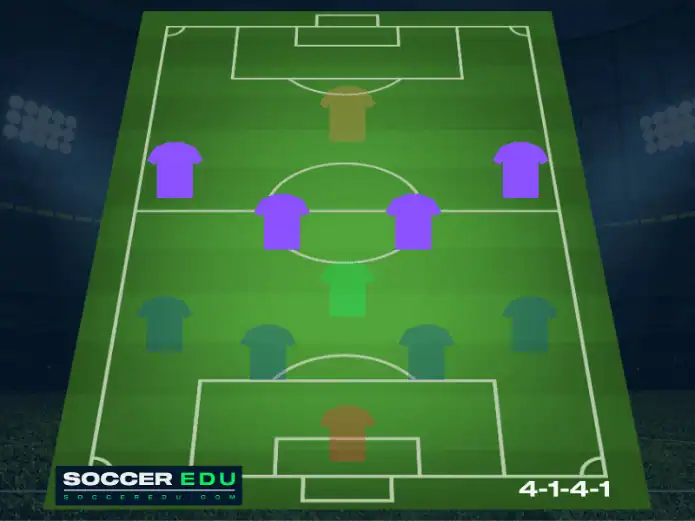The 4-1-4-1 formation is one of the most commonly used systems in modern soccer. Thanks to its many advantages, this setup appeals to numerous coaches worldwide, notably Pep Guardiola with Manchester City (England).
He has made this formation a cornerstone of his tactical approach, which has helped him win numerous titles with his club and establish himself as one of the best coaches in the world. Today, let’s take an in-depth look at the 4-1-4-1 system: Why use it? How does it work? And much more…

Why play in a 4-1-4-1?
The use of this soccer tactic by a coach is a deliberate choice. This 4-1-4-1 formation, which combines both balance and versatility, has evolved over time and established itself as a benchmark in the sport. This setup offers several advantages during a match, which are as follows:
Defensive stability of the 4-1-4-1
The 4-1-4-1 provides defensive assurance through a midfielder positioned in front of the center-backs, acting as a shield. The midfielder plays a key role during defensive phases, serving as the first line of resistance by intercepting passes or dropping back to prevent fast breaks
This defensive calm is further reinforced by a back line consisting of two center-backs and two full-backs, who effectively close down space and benefit from constant support, making it difficult for opposing attackers to reach dangerous areas.
This system is particularly effective at containing quick counterattacks, thanks largely to the holding midfielder’s ability to delay the opposition by either cutting off passing lanes or applying pressure on the ball carrier. This ball recovery work allows the back four to stay focused on marking their assignments.
Defensive advantages of the 4-1-4-1
- Reduction of central space
- Better management of counterattacking situations
Flexibility of this formation
The main strength of this setup lies in its ability to adapt during different phases of the game. The 4-1-4-1 is a hybrid formation that enables a smooth transition between defense and attack (and vice versa) without requiring player substitution.
In offensive situations, the two central midfielders are responsible for leading and directing play. They are supported by the two wingers, who stretch the field as much as possible to widen play and create space in the opposing block. The lone striker may have several roles depending on the coach’s instructions, but generally will drop deeper to help in the build-up or attack the space behind the defenders with runs in behind.
In the defensive phase, the back four and the five midfield players (1 defensive midfielder, 2 central midfielders, 2 wingers) come together to form a compact block that reduces the amount of space that the opposition can exploit. The two lines that make up this block can shift laterally in a coordinated manner to cut off passing options or close in to protect the central channel.
Midfield control
With a five-man midfield, this formation provides a significant advantage over the opposition by ensuring numerical superiority in the center of the pitch. Gaining control of the midfield is crucial in a match, as it allows a team to dictate the tempo and impose its rhythm on the opposing side.
The holding midfielder acts as the first point of distribution and offers a reliable outlet for the more advanced players, helping to secure passes and maintain possession. The two central midfielders, positioned higher up the field, create a variety of short and long passing options and are often the initiators of attacking moves.
The 4-1-4-1 formation often enables teams to control possession due to the midfield’s numerical density, allowing for patient build-up play while providing a solid structure in case of turnovers.
How does the 4-1-4-1 formation work?
The 4-1-4-1 is a structured and versatile formation built around clearly defined roles for each player. Its effectiveness depends on how these players are used and the tactical choices made by the coach.
The structure of this system is based on four lines, each composed of one or more players, with each line playing a decisive role in both offensive and defensive phases.
The defensive line is made up of four players: two center-backs and two full-backs.
The center-backs are tasked with protecting the penalty area by working together to block opposing attackers. The full-backs must defend against the opposing wingers by preventing them from entering the box or delivering crosses, while also contributing to the attack by supporting the wide midfielders during possession phases.

The second line is occupied by a player positioned in a deep-lying role just in front of the defense, acting as a holding midfielder. This player is often seen as an unsung hero, as he typically touches the ball more than anyone else during the match. He plays a key role in transitions, acting as a shield between the opposition and the defense and serving as the first distributor during offensive transitions.

The midfield line consists of four players: two central midfielders and two wide midfielders (wingers). The central midfielders direct the play by distributing the ball or advancing into the playing area. Their role is twofold: to contribute to the build-up during offensive situations and also to provide support during defensive recoveries. The wingers, like the central midfielders, also have a dual role. Positioned on the sides of the pitch, they stretch the play when their team has possession to create spaces in the opposing block. Defensively, they drop back to support the full-backs.

The final line consists of a player positioned at the tip of the attack. This striker plays a crucial role in exploiting depth. He must regularly make himself available for long balls or to redirect passes as a pivot. Therefore, he needs to be able to play with his back to the goal, whether to support teammates or to turn with the ball, and also to properly occupy the deep area of the field.

Key principles of the 4-1-4-1
Teams playing with this formation rely on fundamental principles to make the most of the 4-1-4-1 system. Here they are:
- Compact defensive block
The hallmark of this system lies in its defensive organization, which consists of two compact lines made up of nine players.
These lines drop back in a synchronized manner to form a dense, hard-to-penetrate structure. By creating this block, the team reduces the space in its own half, thus limiting passing options that can bypass defensive lines. Additionally, the coordinated movements of the players close dangerous zones without causing the team to become unbalanced. This defensive style is often used against teams that like to maintain possession and play multiple short passes when building their attacks.
- Quick transitions
When the team regains possession of the ball, the objective is to play forward quickly to surprise the opponent. To achieve this, the players execute a series of quick passes to direct the play towards the wingers or the central striker.
Wide areas are often exploited in this type of situation in order to further disrupt the opposing defense and more easily reach their penalty area.
- Targeted pressing
The 4-1-4-1 formation supports the implementation of “zonal pressing” rather than constant pressure across the entire field. Teams using this setup typically choose either a high press to disrupt the opponent’s initial build-up and win the ball in advantageous areas, or a low press where they sit back and wait in their own half to reduce defensive risks.
Drill to practice the 4-1-4-1 formation
To effectively implement this formation in a match, it’s essential to train with specific drills that develop team chemistry and improve overall efficiency when playing in a 4-1-4-1. Here’s an example of a targeted drill for this formation:
Defending as a block ~ 15-20 minutes
The main objective of this drill is to strengthen the defensive solidity of a team playing in a 4-1-4-1. It focuses on reinforcing organization and communication among teammates, which enhances the effectiveness of collective defending. The drill helps defenders and midfielders maintain a compact shape to manage space and anticipate opposition attacks.
Equipment:
- Cones
- Balls
- Pinnies/training vests
- Mini goals
This drill is performed on a 30×30 meter area and requires two teams: one made up of four defenders and one holding midfielder, and the other of four attackers.
Instructions and procedures:
- The attacking team starts with the ball and must try to break through the defense with quick passing to score in one of the two mini goals.
- The other team must defend by forming a compact shape and working together to intercept passes and regain the ball.
- Once the defending team regains possession, they must quickly reorganize and play the ball into a designated zone. They have 10 seconds to reach this area with a quick transition.
This exercise lasts approximately 15 to 20 minutes (3 to 5 sets of 4 minutes of continuous play, followed by 2 minutes of recovery between each set).

How to counter a 4-1-4-1?
The 4-1-4-1 can be a fantastic formation to face because of its balance and versatility, but it is not invulnerable and there are effective strategies to counter it.
1) Exploit the spaces on the flanks
Exploiting the spaces on the flanks can be an effective strategy against a team playing in a 4-1-4-1. In this setup, our fullbacks tend to push high up the field to support the wingers, which can leave large gaps in the defense, especially toward the end of the match when defenders have accumulated fatigue and struggle to get back into position.
The ideal strategy for this kind of situation is to use fast players on the wings, favoring long balls to catch the defense off guard and launch quick attacks.
2) Neutralize the midfield
Neutralizing the midfield is another effective tactic to gain advantage against a 4-1-4-1.
In this formation, the midfield is built around a double line (four midfielders + one defensive midfielder). Successfully neutralizing this area is crucial in a match to avoid being dominated and forced to keep up with the opponent’s pace.
To take control of the game against a team playing a 4-1-4-1, it can therefore be useful to focus on quick transitions and favor short combinations. Indeed, this helps to move the opposing block and catch the midfielders off guard before they can reposition themselves.
The 4-1-4-1 in MLS: A good idea?
The 4-1-4-1 formation is much more commonly used in Europe than in the North American league. In the Premier League, it has been adopted by clubs like Manchester City, Arsenal and Leeds United in recent seasons.
However, in MLS, no club has used the 4-1-4-1 as a starting formation during the 2024 and 2025 seasons, according to official FBref data. North American teams clearly favor formations like the 4-2-3-1, the 4-3-3 or the 4-4-2, which dominate match line-ups by a large margin.
Yet, introducing the 4-1-4-1 could represent an interesting option for some MLS clubs looking to strengthen their midfield or innovate tactically, drawing inspiration from European trends where this system has already effective.
What is the best soccer formation?
4-4-2, 3-5-2, or even 4-3-3: Many factors must be taken into account to determine the best tactical formation, such as a team’s style of play, the profile of the players in the squad and the opponent to be faced.
Here’s a table comparing the most popular tactical formations based on several criteria :
| Formation | Pros | Cons | Ideal for… |
|---|---|---|---|
| 4-1-4-1 | Balance between defense and attack | Fewer quick offensive options | Teams seeking stability |
| 4-3-3 | Width and midfield dominance | Vulnerable to counterattacks | Possession-based formations |
| 4-4-2 | Simple and balanced | Lacks midfield control | Squads playing direct soccer |
| 3-5-2 | Midfield superiority and wing exploitation | Requires strong defensive discipline | Formations aiming to dominate the game |
The 4-1-4-1, in brief
The 4-1-4-1 tactical system is a formation that offers a combination of defensive solidity and offensive potential, making it a favored choice for many coaches seeking a balance between both aspects of the game. Through this setup, a team can structure its play to be compact and hard to break down while still maintaining offensive options to put pressure on the opponent.





